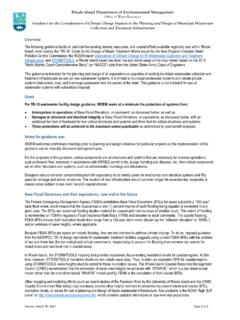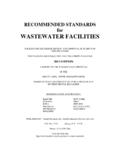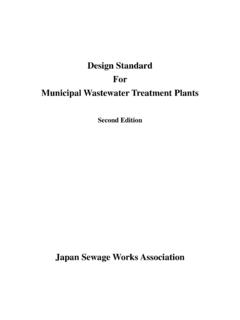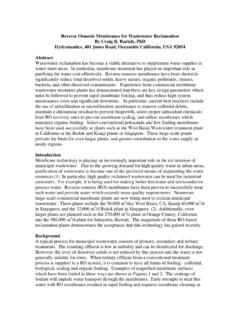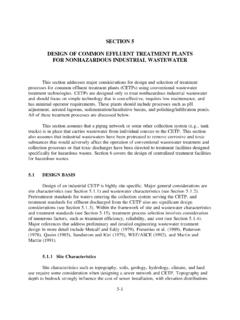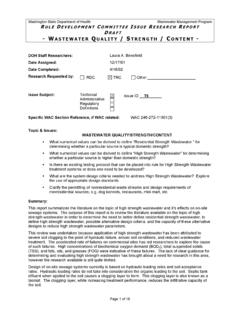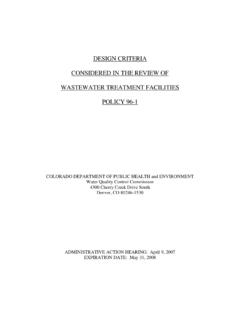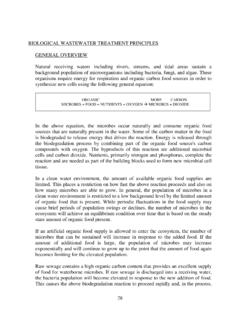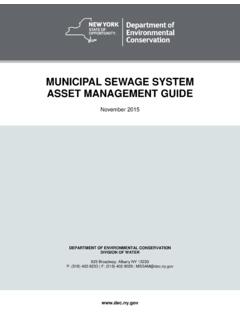Transcription of Wastewater Pump Station Design Problems and Solutions
1 municipal Wastewater PUMP Station Design Problems AND Solutions Presented at: WEFTEC 2006 Dallas, TX October 24, 2006 New England Water Environment Association Meeting Westford, MA September 12, 2006 Virginia Water Environment Association Annual Meeting Roanoke, VA May 2, 2006 municipal Wastewater PUMP Station Design Problems AND Solutions INTRODUCTION In the Northern Virginia suburbs of Washington DC rapid residential growth has resulted in the need for construction of numerous municipal Wastewater pumping stations. municipal pump stations in Northern Virginia typically are submersible type pump stations with a Design capacity between from 100 gpm to 1 MGD.
2 The Design requirements for submersible type pump stations continue to evolve to address construction and operation Problems . This paper identifies several of these Problems and the Solutions that have been implemented in the Design of several recently constructed Wastewater pump stations in Northern Virginia. The author has prepared this paper based on his 32 years of experience in Wastewater pump Station Design in the Northern Virginia Area. METHODOLOGY Each of the identified pump Station Design Problems is listed below by number with the corresponding Design solution indicated under the problem .
3 Problems AND Solutions 1. Concrete Corrosion Protection problem : Until recently, most pump stations in Northern Virginia were constructed of concrete. Typically the wet well interior and exterior concrete surfaces received two coats of a coal tar epoxy coating to protect the concrete from the corrosion due to hydrogen sulfide in the influent sewage. Experience has indicated that concrete corrosion will result if either the coal tar epoxy is not properly applied, or is not reapplied when it deteriorates over time. It is very difficult to reapply coal tar epoxy, because usually the pump Station wet well can not be taken out of service.
4 Solution: New pump stations include a high density polyethylene (HDPE) liner on the interior of the concrete surfaces exposed to Wastewater for corrosion protection. This liner is provided as an option by the precast concrete suppliers and the concrete is formed around the outside of the liner. Following installation of the lined precast concrete structure a certified welder field welds the seams and welds around pipe penetrations to assure that the HDPE liner prevents sewer gas from attacking the concrete. Another alternative is to utilize precast polymer concrete structures.
5 Polymer concrete utilizes epoxy to bind the aggregate instead of cement. Thus the polymer concrete is not susceptible to corrosion due to sewer gas. Contact: Jeff Chapin, 8401 Arlington Boulevard Fairfax, VA 22031 Phone: (703) 849-0555 Fax: (703) 849-0623 2. Corrosion Resistant Materials: problem : Previous pump Station designs included the use of galvanized steel and coated metal components in areas susceptible to hydrogen sulfide in influent sewage. After several years the metal components corroded and had to be replaced. These items included piping, pump guide rails, supports, grating, hand rails, stairs, bar screens, bolts, weirs, ladders, slide gates and other items.
6 Solution: Type 316 stainless steel is specified for guide rails, brackets, bolts, nuts, structural steel, supports, and stairs. Fiberglass grating and ladders are specified. Aluminum hatch covers and slide gates are still specified because they are light way and durable, but they are susceptible to corrosion over time. The exterior of ductile iron piping is epoxy coated. Corrosion resistant materials should also be specified for electrical components. 3. Pump Protection from Influent Sewage Debris problem : Most of the older pump stations had the influent sewer entering directly into the wet well and relied on the ability of the submersible pumps to pump a 3 inch diameter solid.
7 Some pump stations had a basket screen attached to the influent sewer inside the wet well to try to protect the pumps from damage. However, the screens have to be manually lifted out of the wet well and cleaned by hand often to be effective. Solution: In order to assure that the pumps are adequately protected, new submersible pump stations in Northern Virginia often include a comminutor vault preceding the wet well. Raw Wastewater entering the pump Station flows through the comminutor vault influent channel which is equipped with a grinder. The grinder is a hydraulically driven horizontal screen and cutter assembly.
8 The rotating screen directs solids toward and into the cutters where the influent solids are ground into fine particles to protect the downstream pumps . The grinder 5hp hydraulic power pack is located in a fiberglass enclosure mounted on top of the comminutor vault. In the event the grinder must be taken out of service, slide gates are provided to direct comminutor vault influent flow to a bypass bar screen. Also, in the event flow backs up upstream of the grinder the influent channel wall has an overflow notch just upstream of the bar screen. The bar screen is constructed of stainless steel bars and must be manually cleaned with a rake.
9 The comminutor vault is a 12 ft. diameter precast concrete manhole with an HDPE liner. Stainless steel alternating tread stairs are used for access to the bottom of the vault. All lighting and electrical equipment is explosion proof inside the vault. A ventilation fan is provided on top of the comminutor vault. 4. Pump Selection Based on Total Dynamic Head Calculations pumps are selected based on total dynamic head (TDH) calculations which can lead to improper sizing unless the Engineer carefully considers the exact pipe inside diameter, the Williams Hazen flow coefficient (C), and the location of high points in the force main.
10 Each of these factors is discussed as follows: Inside Pipe Diameter: Typically in Northern Virginia force main piping is either double cement lined ductile iron pipe or PWC pipe per AWWA C-900. The inside pipe diameter may vary considerably depending on the type of pipe selected. For long force mains extending two or more miles in length this can result in a significant difference in friction head component of the TDH. Solution: Determine the type of force main to be constructed and the exact inside pipe diameter in preparing TDH calculations. If the force main could be either ductile iron pipe, PVC or some other material, the TDH calculations should be prepared for each possible pipe material to make sure that the selected pump is adequate for all pipe materials.


